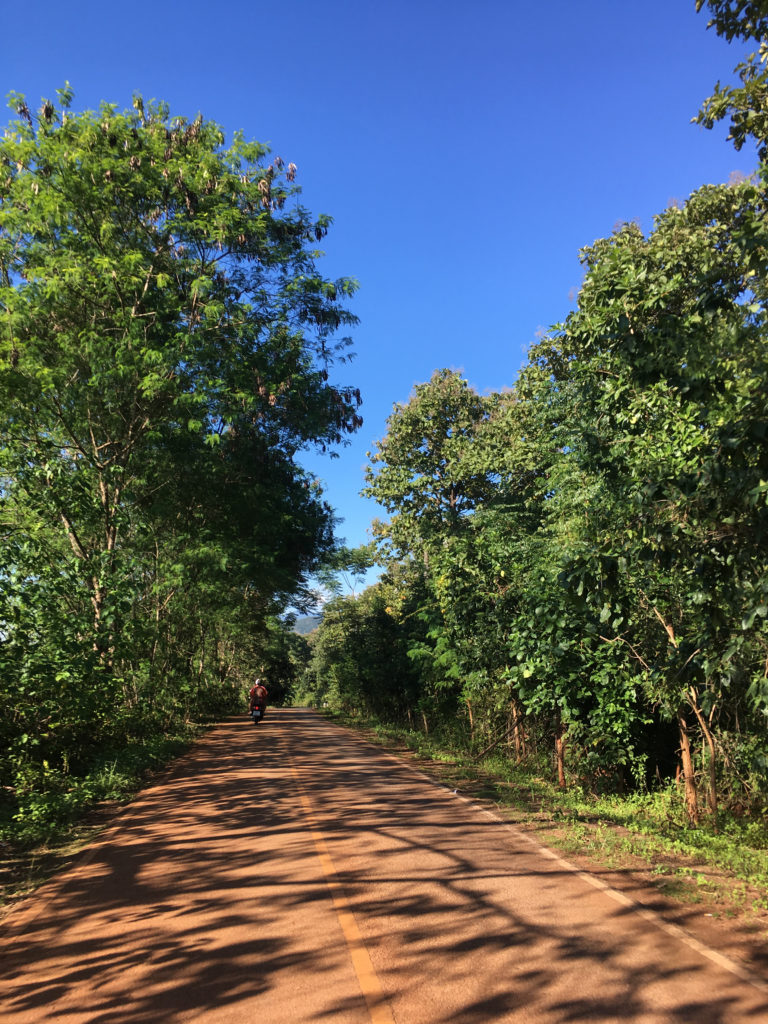 Learning to ride a motorbike abroad will open up a world of possibilities. You are able to travel at any time of day or night, explore secret corners of each city as well as deep interiors of islands without much planning. Once you’re confident on a motorbike, a newfound freedom will have you scooting the days away in search of adventure that is available to only those with the skills to get them there.
Learning to ride a motorbike abroad will open up a world of possibilities. You are able to travel at any time of day or night, explore secret corners of each city as well as deep interiors of islands without much planning. Once you’re confident on a motorbike, a newfound freedom will have you scooting the days away in search of adventure that is available to only those with the skills to get them there.
Personally, I had a horrible first day. I was confused, anxious, scared, and feeling quite incapable. I ended up letting my best friend drive me around for the next year and while I was quite happy with the situation, I had no idea what I was missing until five years later when I was forced to try again. Cut to five days after that and I was zipping through rush hour traffic in Chiang Mai like a little pro. Force yourself out of your comfort zone and the world will expand in front of you. Learning to confidently ride a motorbike was quite possibly my biggest accomplishment of 2016, and something I can only improve upon for the rest of my life. Here’s how to start:

Find a trustworthy teacher if possible – if you are learning to ride abroad, chances are you will have to teach yourself unless you can speak the local language. That’s okay! You can do this, proceed to tips 2-10. If you do have access to a teacher, pick their brain. Ride on the back of a motorbike with them and ask them to talk to you the entire time about what they are thinking and doing. Riding a motorbike is quite tiring as you are always looking ahead, premeditating what could happen pertaining to the terrain, other traffic, and other unpredictable variables. You are basically making an escape plan every second just in case something upends the normal conditions so you can scoot away without an accident.
Find a bike & helmet you’re comfortable with – this is really important. You need to feel confident with your equipment. Do not rent a bike that turns over three times before starting or a helmet that slips down on your forehead over each bump. I have done it and it is not worth the frustration and potential accident. Your bike should feel like an extension of yourself. If it feels too big and powerful you will unknowingly carry a fear and intimidation factor with you as you ride. Find a bike that you feel at home on so that you are the most relaxed you can be while riding. In my opinion, the helmet is even more important. Find a helmet that fits your head perfectly. A helmet with a bug shield is even better as debris tends to kick up while you’re riding in dusty cities and washed out island roads. If you do not see a proper helmet where you rented your bike, go to another rental place and ask to rent a helmet from them. You will probably have to leave a deposit, but it is absolutely worth the trouble to find a proper fitting helmet. Finding a comfortable helmet could be the difference between a safe ride and an accident. If you’re messing with your lopsided helmet while driving, you’re not giving the road your full attention.
Wear the proper gear – you don’t need a leather jacket, but I think it’s imperative to wear sneakers when you’re first learning. You will use your feet to balance when you stop the bike and on day one, starting, stopping and turning the bike take some getting used to. It’s best to protect those tootsies. While riding a motorbike, there is nothing to protect your precious body from the road, other vehicles or flying debris. Take a moment to think about that before you hop on a bike. Lather on the sunscreen, wear sunglasses to protect your eyes and consider wearing more than just a bathing suit. Do I sound like a worried mother? Good. Almost everyone I’ve met who rides abroad has gotten into some type or minor (or major) accident and they all have a scratch or scar to prove it. Protect your adventurous self by adding another layer between you and the road.
Talk everything through – this sounds silly, but I’m basically advising you to be mindful. Talk each maneuver through in your mind while you’re doing it. Even the silly stuff like putting up the kick stand, pressing the break, turning the key, etc. Not only does this mean you are focusing 100% on your actions, but you’re also learning how to troubleshoot should something go wrong in the future. For instance, when I was trying to back my bike up over a three inch curb, it would have been helpful if I was being mindful and thinking the situation through, but instead I tried to muscle it backwards (there’s no reverse on motorbikes), not thinking about the fact that my bike was turned on and therefore gripping the handles and pulling it backwards will also engage the gas and cause the bike to jolt forward. Thankfully there wasn’t a cliff in front of me or I would have been dead. Yup. Riding a motorbike is serious and accidents don’t always involve other vehicles. Talk it through and take it slowly.
Stash valuables inside the seat and ride alone – this is the best way to start, if even only for your first fifteen minute ride. Your partner can stand in the shade and sip on coconut water while you get a feel for your bike. It’s really helpful to start as a single rider so you can obtain an understanding of the delay upon engaging the gas and the vehicle moving forward, the responsiveness of the breaks on flat and inclined surfaces and the feel of the weight distribution while turning. Like most anything, you will get more comfortable and knowledgeable with each hour of practice, starting alone will give you the foundational feel you need to successfully and safely ride with someone else.
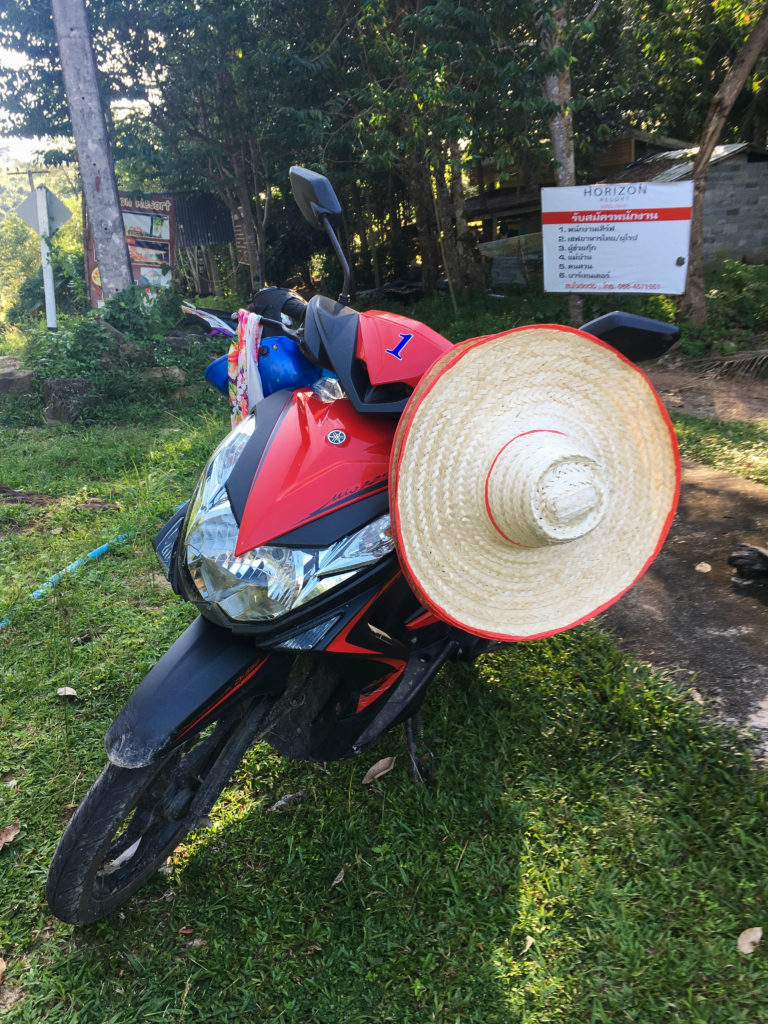
Start slow on a deserted island – not kidding. Starting slowly in a place with a population of 12 will simultaneously calm your nerves and build your confidence. As a new rider, even putting the kickstand up and feeling the weight of your bike for the first time may seem off-putting. That’s when Tip 3 comes in and you think squeeze the breaks, which steadies the bike 😉 at which point you turn the key to start the vehicle. Pull back slowly and steadily on the throttle (the right handlebar grip) and you’ll feel the weight of the bike start to lift and disappear until it begins to move forward. Even this tiny motion is worth practicing over and over again. I seriously had no idea that there was a minor delay in engaging the throttle and the bike moving forward. My first day on a motorbike (over five years ago) was terrifying as I would jolt forward rapidly each time not exactly sure how to accelerate with control. It wasn’t until I had a minor crash that my friend realized what I was doing and how I could easily fix my mistake. I simply had to pull back slowly, it’s like easing on the gas instead of jamming your foot down, but if you’re new to bikes, how are you supposed to know?! They may look like toys, but they’re not. Lesson learned. Start slowly and talk each motion through that way you have a full understanding of the mechanics and actions behind your movements.
Know where you’re going – this is key so you’re not slamming on your breaks after missing a turn or trying to pull out your cellphone. I think it’s a good idea to glance at a map before taking off so you have a general idea of your route. If you do miss a turn or see it an instant too late, don’t slam on your breaks, take your time, travel further down the road and safely turn around. Think of all these missed turns and extra side streets as good practice for a motorbike beginner.
Graduate to more complicated maneuvers & test your skills – It’s easy to stay on the deserted island or to avoid intersections, steep hills and sharp curves, but will you improve this way? If you’re truly confident with each maneuver you’re already employing, it’s time to test yourself a bit. Work on turning around in tight spaces and driving confidently up, down and around curvy inclines. Test your skills on flat, packed dirt, unpaved roads and even washed out, uneven, rocky roads. Also work on maneuvering your bike when the engine is off as it’s quite a common procedure for pulling out of tricky parking situations. Getting more comfortable with a variety of situations will help you deal with them in the future and also prepare you for even trickier times.
Practice riding among traffic – once you are completely comfortable with your bike and the way it operates, you are ready to enter the flow of traffic. Adding other vehicles to the equation comes with a whole new set of challenges. Depending on the country you’re traveling in, local drivers will know how to avoid and interact with you, a new driver. Therefore you should worry about you and your actions. You are the only driver on the road you can control. Always assume you are invisible and others can’t see you. Thinking this way will cause you to drive smarter and with more efficiency. You’ll also look further and further ahead in traffic and notice possible situations and how to potentially avoid them. That doesn’t mean you are not fully focusing on what you’re doing at the moment, it just means you are noticing more up ahead than your physically seeing, if that makes sense. As you become comfortable in light traffic, slowly begin to travel on busier routes. Wind your way up to the front of the pack at the intersection, if it’s common where you’re driving, (in Thailand traffic resembles the starting line of Mario Cart!) and take off with confidence. If you’re navigating with ease and you are feeling safe and confident in your actions you’re making progress 🙂
Add a buddy to the back – it’s so much more fun to ride with a friend. Adding a buddy on the back is helpful too as they can navigate for you, which takes an element off your plate. Friends make everything more fun, but do not bring on a passenger before you’ve excelled at tip 1-9. Only shitty friends act with false confidence and crash with their besties on the back. I’m only half kidding.. I see it all too often, a new driver doesn’t want to appear weak or inexperienced so they bring on a passenger right away. It’s downright dangerous. Someone’s life is in your hands, be responsible. Your friend will thank you for a safe ride even if he or she had to wait a day or two while you practiced alone on the bike.
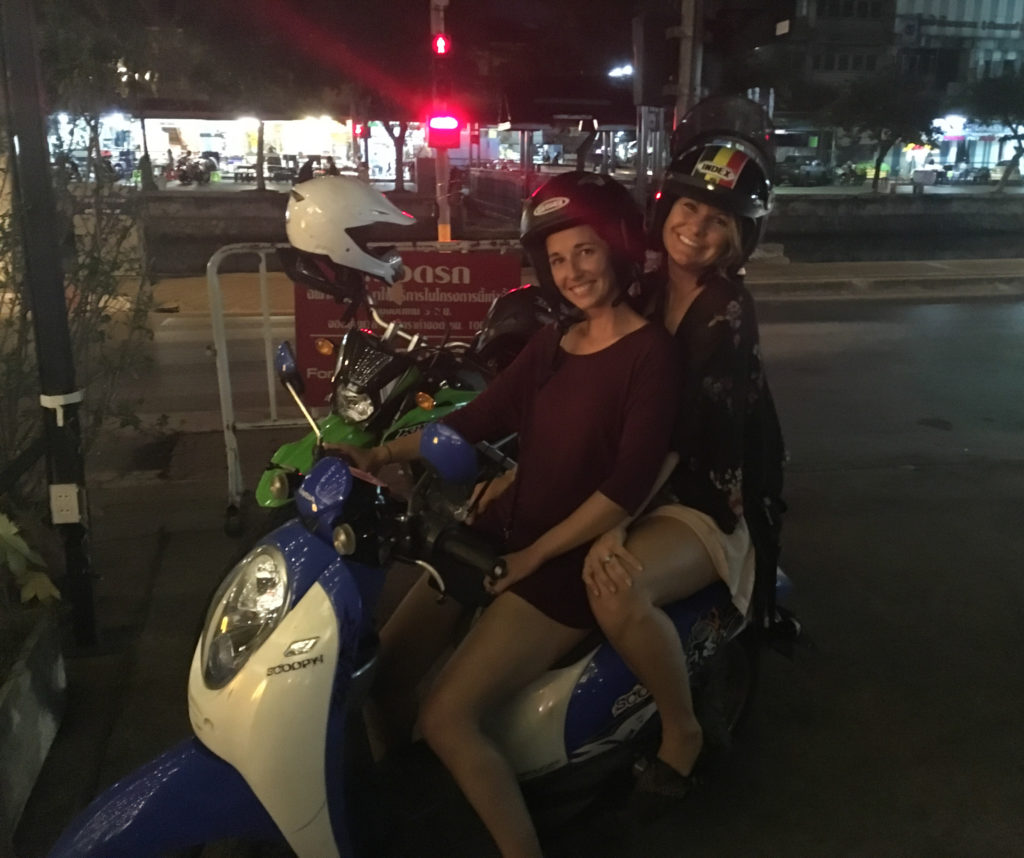
Some more obvious tips ::
NEVER DRINK & DRIVE – Duhhhhhhhhhhhh
Take photos of every little inch of your bike! This is helpful if the person you rented from turns out to be a dick and tries to squeeze more money out of you.
Step onto the bike from the left side – this is quite obvious as the extremely hot muffler resides on the right side of the bike, but if you’ve never been a passenger you wouldn’t know. An inner right calf burn (tell-tale sign of a muffler burn) is actually referred to as a Thai tattoo.
Go with the flow – allow your body to be loosey goosey as a driver and passenger, you want to go with the flow of the bike, not fight it.
Be prepared to hop away from your bike if it’s going down as many injuries are from the bike landing on you or the muffler burning your leg.
If you’re a passenger – hop off the bike before parking and hop on after your driver pulls out. It makes things a lot easier and you’re able to conserve precious parking space.
Remember to disable your turn signal – I feel like turn signals are rarely used in Thailand, but as a westerner, I’m always signaling. You need to manually disable turn signals by pressing the little button after each turn, which becomes second nature, but it’s usually forgotten when you turn into a parking spot and immediately turn off the bike. If you’re in bright sun you won’t see the light flashing and you’ll leave it on all during lunch causing your battery to die.
I’ve made plenty of mistakes – the first day I drove around in a maxi skirt without a helmet, like WTF? Take it slow and learn from others’ mistakes – swap stories with fellow travelers and always be mindful of your movements to further educate yourself on proper technique. Good luck!
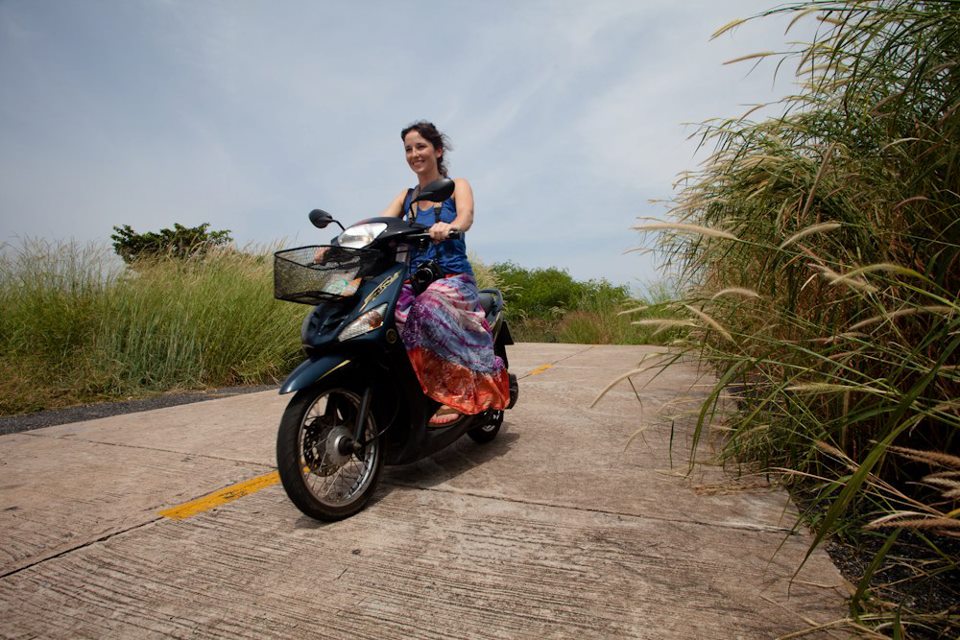
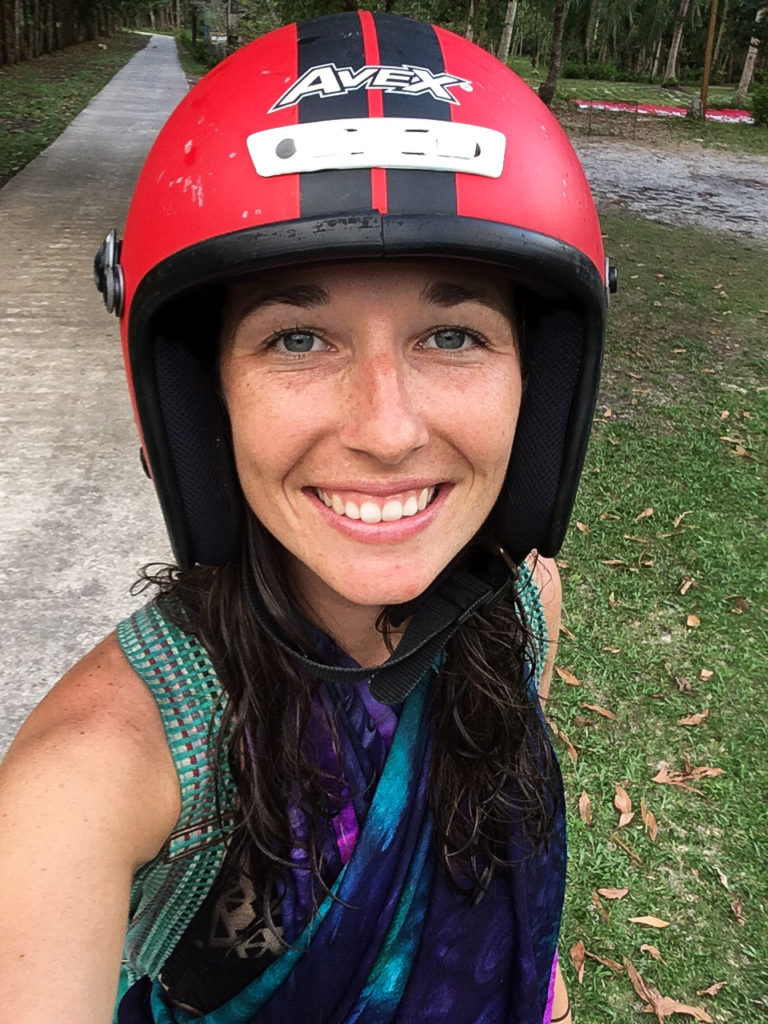

The article is really helpful! Learning how to ride a motorcycle abroad is going to open up the world of possibilities. You can travel any time whether day or night. When you become confident on your motorbike, fresh freedom is going to have you scooting in search of various adventure that are just available to those who possess the skills.
Thanks, Stanton! And we couldn’t agree more!
That makes sense to wear sneakers. You’ll want something to protect your feet from the road. I’ve always wanted a bike, so I’ll have to start learning how to ride.